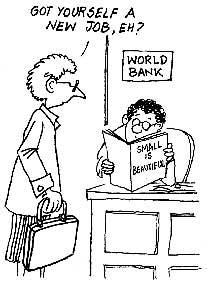The big farce
 in a study titled, The World Bank's ( wb ) experience with large dams: a preliminary review of impacts dated September 1996, the Operations Evaluation Department ( oed ) of the wb has concluded from a desk assessment of 50 Bank-financed large dams that the wb should continue to conditionally supporting the development of large dams. The conditions require that the projects comply strictly with the new Bank guidelines and the design, construction and operation of new projects take into account the lessons from previous experiences.
in a study titled, The World Bank's ( wb ) experience with large dams: a preliminary review of impacts dated September 1996, the Operations Evaluation Department ( oed ) of the wb has concluded from a desk assessment of 50 Bank-financed large dams that the wb should continue to conditionally supporting the development of large dams. The conditions require that the projects comply strictly with the new Bank guidelines and the design, construction and operation of new projects take into account the lessons from previous experiences.
The critics are not impressed, as the record till date shows that these conditions are almost always violated. Says Patrick McCully, campaigns director for the International Rivers Network in the us , "The sources of data have been the dam agencies themselves, so the answers are not surprising.' Thus, the study, that was commissioned "to deal with the fundamental issues that underlie the controversy', is unlikely to be of much help to the wb if it was looking for excuses to push ahead with funding more big dams.
Most revealingly, the report does conclude that only a quarter of the projects that have been reviewed were implemented so as to comply with the Bank's current criteria. But the report finds solace by putting forward a hypothetical and theoretical proposition that mitigation of the adverse social and environmental consequences of large dams would have been both feasible and economically justified in 74 per cent of the cases. This still means that at least in 26 per cent of the cases reviewed, even by present standards, the social and environmental impacts would not have been mitigated. In any case, if the history of wb funded projects in India including Sardar Sarovar, Upper Krishna, Suvernarekha or Indravati is anything to go by, the record of implementation of "Bank's current, more demanding criteria' is dismal.
Robert Goodland of the wb 's environment department in Washington says, "I'm fighting like hell to make sure that we keep financing hydro-dams.' Goodland has set up elaborate guidelines to test if a dam should be built or not. However, as the September issue of international journal Infrastructure Finance says that "few existing dams could pass these tests'. In spite of the statement by the wb President James Wolfensohn when he visited India recently that "what has happened in Sardar Sarovar is a tragedy and I get distressed when I hear about it', it is clear that the Bank management is bent on pushing ahead with the big-dam-centered water and power policies.
Related Content
- Trade and Development Report 2020- From global pandemic to prosperity for all: avoiding another lost decade
- Guaviare: Colombia’s frontline in the country’s battle to stop deforestation in the Amazon
- Mobile pollution checks turn into a farce
- Study on Cell Tower Radiation a Farce: Scientist
- Endosulfan report a farce: samara samithi
- Green tribunal says ‘no' to Jindal steel
